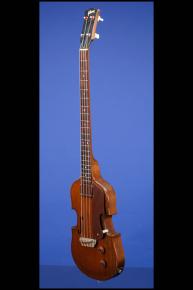A Near Mint Example of an Early "EB-1"
1954 Gibson Electric Bass (EB-1).
This very early violin-shaped "EB-1" bass guitar with painted-on f holes (in black) weighs just 8.40 lbs. and has a nice, fat nut width of just over 1 11/16 inches and a scale length of 30 1/2 inches. Solid (two inch thick) mahogany body with a width of 11 1/2 inches and two black 'pencil' lines around the outline on the top and bottom. One-piece mahogany neck with a wonderful medium-to-thick profile and unbound rosewood fretboard with 20 thin frets and inlaid pearl dot position markers. Headstock with inlaid pearl "Gibson" logo. Black plastic truss-rod cover. Two-on-a-side Kluson banjo-style tuners with rear-facing Keystone plastic keys. Serial number ("4 1991") inked-on in black on the back of the headstock. One Alnico magnetic pickup with a brown Royalite cover and a huge output of 16.28k. Brown plastic pickguard. Two controls (one volume, one tone) on lower treble bout. Brown plastic barrel-shape half-inch "Speed" knobs. Side-mounted jack socket. Combination "wrap-over" bar bridge/tailpiece with two adjustment screws. The pots are dated "134 320" (Centralab May 1953). All hardware nickel-plated. There are a couple of very small surface 'cuts' on the top treble edge of the body (adjacent to the pickup), otherwise this is a spectacular and totally original example in near mint condition, by far the finest we have ever seen, complete with it's original telescoping end-pin and the original hang-tag. Housed in the original brown four-latch hardshell case with pink plush lining (9.25).
"In the late 1930s Gibson took another foray into the low end with the Electric Bass Guitar - the name, if not the instrument itself, proving prophetic. An over-size, 4-string hollowbody guitar made of solid maple, it was equipped with an endpin for stand-up playing and had a magnetic pickup similar to the Charlie Christian-model guitar pickup. The curved fingerboard had 24 inlaid fret markers, making it the first "lined fretless." Scale length was an upright-like 42 3/4". According to Gibson historian Julius Bellson, only two Electric Bass Guitars were made between 1938 and 1940, before World War ll shut down product development. It's interesting to speculate about what might have happened if Gibson had been able to follow this line of thought.
Gibson didn't re-enter the electric bass market until two years after after the introduction of the Fender Precision Bass. The Gibson Electric Bass of 1953, like the Electric Bass Guitar of the late '30s, was equipped with a telescoping endpin for upright playing - but this time the instrument had a small, violin-shaped solid-mahogany body (with painted-on f hole) and a scale length of only 30 1/2". The short scale was intended, apparently, to make it more appealing to guitarists, an impression that would seem to be confirmed by the inclusion of frets and a pickguard. The large single pickup had a brown plastic cover and was mounted at the end of the neck. The tuners were banjo-style, with rear-facing knobs on the back of the peghead. The Electric Bass was renamed the EB-1 in 1958, when Gibson introduced another electric bass, but discontinued within the year. Only 546 were made between 1953 and 1958. Updated with a chrome-covered humbucking pickup and some cosmetic refinements, the EB-1 made a brief comeback in 1970 but was dropped again two years later " (Jim Roberts, American Basses, p. 73).













